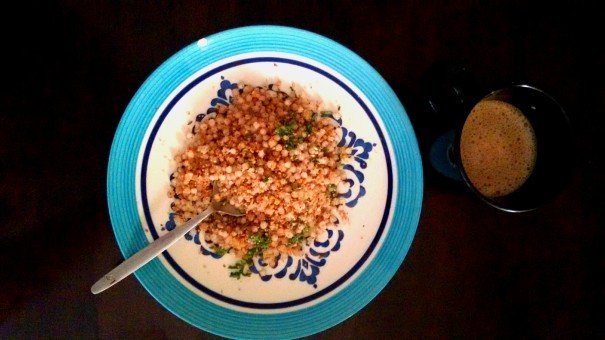
The Translucent Pearls of Breakfast Wisdom

The Translucent Pearls of Breakfast Wisdom
Sabudana Khichdi in Mumbai
Stirring the wok with a wooden spatula and maintaining a low flame on my stove, I see the tapioca pearls of my sabudana khichdi (stir-fried, savory tapioca pearls) slowly turning translucent. I have just added the coarse, ground mixture of peanut powder and chillies into the wok that the pearls and the shallow fried potatoes are catching. In a minute, I will turn down the flame, add the chopped cilantro, and squeeze in half a lemon and some salt to complete the dish before spooning it onto my breakfast plate for a light breakfast.
It wasn’t always this easy. The first time I attempted making sabudana khichdi, I ended up with an ingloriously lumpy mess of sticky tapioca pearls in the pan, indicating breakfast tomfoolery. The ostensibly simple recipe is equally tricky to follow and success lies in its soaking. I’d soon enough learn that sabudana needs to be soaked in just enough water so the pearls are not completely immersed in it. They soak up the water and swell in size by the next morning, when they need to be fluffed up with a fork to separate them and keep them from getting clumpy.
For a religious Hindu, particularly in the Western Indian states of Maharashtra and Gujarat, sabudana is staple food during the auspicious fast days, called vrat. Made from cassava root, these tiny balls are not grain and hence allowed for consumption while fasting. They are made into vadas (deep fried patties) as an evening snack, kheer as an after dinner dessert, and even gruel that aids to cope with digestive issues.
But none of these dishes are as significant as the Maharashtrian specialty sabudana khichdi. When made right, sabudana is feathery light and translucent. It is starchy, however, because tapioca and potatoes are high sources of carbohydrates that allow a fasting Hindu to get through the day. Made from soaking sabudana overnight, a process that fluffs up the pearls and makes them translucent while exposed to heat, sabudana khichdi has also found recognition as diet food.
It is somehow perplexing that the major producer of sabudana, the state of Tamil Nadu in India, is not its major consumer. The only known dish made out of sabudana in Tamil Nadu is the kheer, a sugary dessert made by boiling the pearls with milk and sugar. The love for rice as staple grain in Tamil Nadu trumps the popularity of pseudo-grains like sabudana, where idli (steamed rice cakes) and dosa (savory pancakes), made with fermented batter of rice and black Bengal gram, rule the roost in breakfast tables.
Albeit hailing from the land of idlis and dosas, my breakfast table, however, is a culinary potpourri of experimentation where breakfast dishes from various regions commingle. From being a sabudana khichdi novice, I have come a long way in perfecting the recipe.